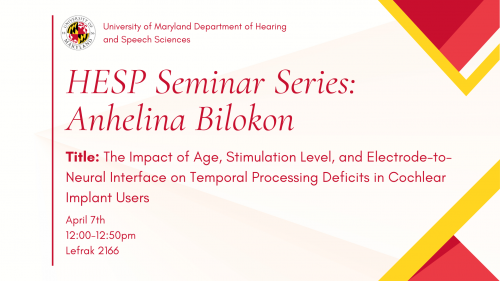Event Date and Time
-
Location
LeFrak Hall Room 2166
Speaker: Dr. Anhelina Bilokon
Title: The Impact of Age, Stimulation Level, and Electrode-to-Neural Interface on Temporal Processing Deficits in Cochlear Implant Users
Abstract:
Cochlear-implant (CI) performance outcomes are highly variable. One factor contributing to this variability may be age-related deficits in temporal processing, which can be assessed through recovery from forward masking (RFM). Older CI participants exhibit longer RFM functions, particularly in regions with a poor electrode-to-neural interface (ENI). ENI is a combination of peripheral neural and non-neural factors that impact the effectiveness of electrical stimulation. Additionally, temporal processing deficits appear to be exacerbated with increasing stimulation levels of speech stimuli, potentially due to a central processing deficit. However, level-dependent temporal processing deficits have not yet been thoroughly established through controlled direct stimulation experiments. This study aims to investigate the effects of stimulation level on RFM, measured at electrodes with varying ENI. We hypothesized that older CI participants would exhibit longer RFM than younger participants, especially at higher stimulation levels and in regions with poorer ENI. Participants were recruited across the lifespan (ages 35-85 years). For each participant, ENI was assessed across the entire electrode array using the slope of the evoked compound action potential (ECAP) amplitude growth function and the slope of multipulse integration (MPI). Electrodes with the best, median, and worst ENI were selected for further analysis. After electrode selection, the participant's dynamic ranges (DR) were measured for both the masker (200 ms) and the target (20 ms) stimuli on individual electrodes. RFM thresholds were assessed with varying masker levels (40%, 65%, 90% DR) and masker-target intervals (MTI: 0, 50, 100, 150, 200, 250, 300 ms). As expected, data showed variability in RFM across participants and electrode locations. RFM was notably longer at higher masker levels. Critically, the current results suggest a potential interaction between age, stimulation level, and ENI in affecting RFM, particularly in older CI participants, which aligns with our hypothesis. Understanding the roles of peripheral versus central factors in temporal processing deficits could offer insights into speech perception abilities in CI users. Furthermore, these findings could provide individualized, age-specific programming guidance for clinicians.



